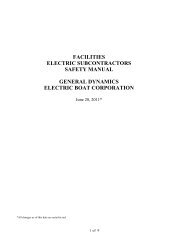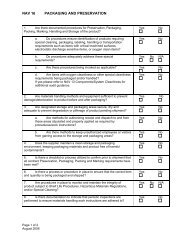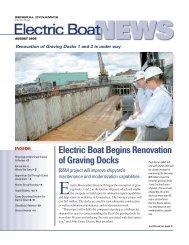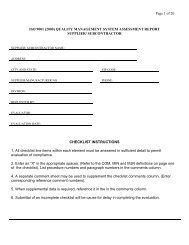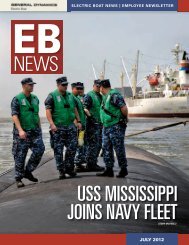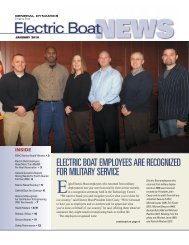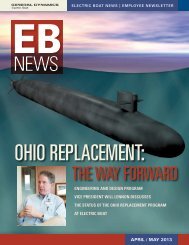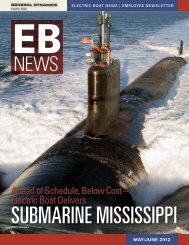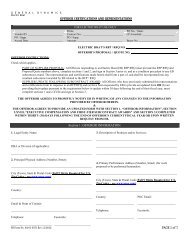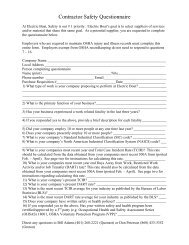more than 1000 employees attend groton health fair - Electric Boat ...
more than 1000 employees attend groton health fair - Electric Boat ...
more than 1000 employees attend groton health fair - Electric Boat ...
You also want an ePaper? Increase the reach of your titles
YUMPU automatically turns print PDFs into web optimized ePapers that Google loves.
JUNE 2011<br />
INSIDE<br />
Harcut Holds Company Career<br />
Longevity Record • 2<br />
New Hires • 3<br />
Fletcher Spells Out the ABCs of IPDE • 4<br />
Process Engineering Expands Its<br />
Ranks with New Class of “Belts” • 6<br />
Marine News Roundup • 7<br />
Retirees • 7<br />
Health Matters • 8<br />
EB Honored for Promoting<br />
Healthy Lifestyles • 9<br />
Service Awards • 10<br />
Ethics • 11<br />
Safety Performance • 12<br />
MORE THAN 1,000 EMPLOYEES<br />
ATTEND GROTON HEALTH FAIR<br />
During <strong>Electric</strong> <strong>Boat</strong>’s annual Groton Health Fair held this month, Preston Tischer,<br />
a summer trainee in Dept. 445, undergoes a body fat/BMI analysis. The event on<br />
the Main Yard hill and the Technology Center cafeteria attracted <strong>more</strong> <strong>than</strong> 1,000<br />
<strong>employees</strong> and featured cholesterol screenings, blood-pressure screenings,<br />
massage therapy, glucose testing and body fat analysis.
IT’S OFFICIAL:<br />
HARCUT HOLDS COMPANY CAREER LONGEVITY RECORD<br />
“ I had some real<br />
good jobs, some<br />
very interesting jobs,<br />
with some really<br />
good people, and<br />
good supervisors.<br />
If I didn’t like what I<br />
was doing I wouldn’t<br />
still be here, but 55<br />
years does go by<br />
pretty fast.”<br />
— Joe Harcut<br />
After four years as a quartermaster in the Navy, Joe Harcut<br />
found work at a local lumberyard. The job lasted only<br />
about a month, when someone dropped a bundle of<br />
shingles on his foot and left him on crutches. Harcut heard <strong>Electric</strong><br />
<strong>Boat</strong> was hiring and, despite the crutches, landed a job as a pipefitter.<br />
“I figured I’d be here approximately five years,” Harcut said. “That<br />
was my plan — to see what it was like, if I liked it or not. I figured<br />
after five years I would know whether I was going to stay or not.”<br />
He liked it. In June, Harcut, a logistics specialist in Dept. 495,<br />
celebrated 55 years with the company, surpassing the previous record,<br />
held by Robert B. Acker, a designer who retired in 1957 after 54<br />
years.<br />
“I had some real good jobs, some very interesting jobs, with some<br />
really good people, and good supervisors,” Harcut said. “If I didn’t<br />
like what I was doing I wouldn’t still be here, but 55 years does go by<br />
pretty fast.”<br />
Harcut said he never divulges his age, but even his children have<br />
worked at EB longer <strong>than</strong> many people ever stay at one job — son<br />
Joseph S. Harcut, a designer, has put in 32 years, and his daughter<br />
<strong>Electric</strong> <strong>Boat</strong>’s<br />
longest-serving<br />
employee, Joe<br />
Harcut, was<br />
recognized recently<br />
by President John<br />
Casey and his<br />
staff for 55 years<br />
with the company.<br />
With Harcut are<br />
his son, Joseph S.<br />
Harcut (495), and his<br />
daughter, Monica<br />
Harsmanka (443).<br />
2 | ELECTRIC BOAT NEWS | JUNE 2011
Monica Harsmanka (443) is approaching 30<br />
years — a total of 117 years of <strong>Electric</strong> <strong>Boat</strong><br />
experience among them.<br />
The elder Harcut and his children were<br />
honored recently at a breakfast with<br />
President John P. Casey and his staff.<br />
“We respect what you have done for<br />
yourself, for your family, and for your<br />
company,” Casey said. “Few people<br />
can even hope to achieve this kind of a<br />
milestone.”<br />
Acker, the previous record-holder for<br />
career longevity, had driven John Philip<br />
Holland, designer of <strong>Electric</strong> <strong>Boat</strong>’s first<br />
submarine, around in a horse and buggy,<br />
and later worked on every EB submarine<br />
from the Holland to the Nautilus, the<br />
world’s first nuclear submarine.<br />
Because Nautilus was on sea trials when<br />
he arrived, Harcut’s first assignment was<br />
on the nation’s second nuclear submarine,<br />
Seawolf, which had an experimental<br />
sodium-cooled reactor.<br />
He spent 14 years in pipefitting at a<br />
time when there weren’t many computers.<br />
Tradesmen in those days bent pipe freehand<br />
according to a sketch made from an<br />
engineering drawing, and then brought it<br />
onto the ship to finish bending it there.<br />
“Pipefitting was a little bit easier in those<br />
days,” Harcut joked.<br />
From there he moved to design, where<br />
he spent 20 years as a draftsman, then to<br />
engineering. He now works in Director<br />
Jackie Krause’s organization.<br />
The younger Joe Harcut has 32 years of<br />
service, but he doesn’t hope to match his<br />
father’s record.<br />
“I will not be here 55 years. I enjoy what<br />
I do, but I think I’ll retire when I’m 67 or 68<br />
— that’s probably good enough for me,” he<br />
said. He joked that if he can get his dad to<br />
stay another 10 years, “we can do a double<br />
retirement.”<br />
Harsmanka said she is always amazed<br />
that after 55 years her father still has<br />
an outstanding work ethic. She recalled<br />
telephoning him one morning when he<br />
was on a road job at the submarine base<br />
in Bangor, Wash. Because of the time<br />
difference, it was 6:30 a.m. in Bangor when<br />
she called, so she wondered if he would be<br />
at work yet. The answer she received — he<br />
had already clocked in “and was down on<br />
the boats solving problems.”<br />
WELCOME TO<br />
330 Courtney McCall<br />
408 Cheli Barie<br />
410 Mark Grigg<br />
James King<br />
Paul Lindenfelzer<br />
412 Christopher Wright<br />
413 Robert Rossier<br />
425 Sarah Beckius<br />
437 Kelly Dixon<br />
449 Jason Taylor<br />
462 Joshua Paterson<br />
416 Zachary Bowe<br />
Jeremiah Francis<br />
Molly Gardner<br />
421 Kenneth Taylor<br />
427 Nuecell Butler<br />
Andrej Dukalev<br />
429 Nicholas Parrott<br />
433 Thomas Alexander<br />
Robert Dircks<br />
Mark Wade Jr.<br />
434 Jeff Magnusson<br />
437 Jeji Cherian<br />
443 Amber Dumas<br />
448 Christine Lowrie<br />
Christopher Noble<br />
Robert Silva<br />
449 Christopher Halbert<br />
Daniel Kelsay<br />
Nicholas Laboe<br />
454 John Tkach<br />
458 Raegan-Lauren<br />
Garside<br />
462 Edmond Cheung<br />
463 Dennis John<br />
480 Amy Burke<br />
ELECTRIC BOAT<br />
PLEASE HELP WELCOME THE FOLLOWING EMPLOYEES, WHO<br />
HAVE RECENTLY JOINED THE COMPANY<br />
Dan Barrett, Editor<br />
Bob Gallo, Gary Slater,<br />
Gary Hall, Photography<br />
485 James Dunlap<br />
Joshua Flacke<br />
Richard Hogan<br />
Geoffrey Howe<br />
Eric Schroder<br />
487 Steven Baldwin<br />
Benjamin Hansen<br />
Mark Peterson<br />
Elliot Walker<br />
492 Scott MacFarlane<br />
493 Rachel Fradkin<br />
494 Neil Cummings<br />
626 Joseph Heiberger<br />
660 Todd Moore<br />
Stephen Scibilio<br />
Andrew Spencer<br />
707 John Hodges<br />
776 Marshall Kaniaupio<br />
902 Brian Bowie<br />
Matthew Carr<br />
Matthew Deery<br />
Richard Deery<br />
Albert Gomes<br />
Eric Jones<br />
Matthew Randolph<br />
Joseph Pires<br />
Thomas Sliney III<br />
Ryan Spurr<br />
Jeffrey Young<br />
904 Michael Cashman<br />
Kathy Perez<br />
915 Jerel Allen<br />
<strong>Electric</strong> <strong>Boat</strong> News<br />
is published monthly by the Public<br />
Af<strong>fair</strong>s Department,<br />
75 Eastern Point Road,<br />
Groton, CT 06340<br />
James Carson<br />
David Cunetta<br />
Steven Hogan<br />
Timothy Welch<br />
921 Joel Bausch<br />
Mark Cotoia<br />
Joseph Demello<br />
Louis Giardini<br />
Alan Haney<br />
Douglas Izzi<br />
Edward Maroney III<br />
Connell McCormick<br />
Jason Miranda<br />
Nicholas Moriarty<br />
Sean Murray<br />
Diane Noonan<br />
John Pereira Jr.<br />
Joshua Prescott<br />
Joseph Solt<br />
Talya Stebbins<br />
Douglas Watters<br />
922 Kevin Noonan<br />
Phone (860) 433-8202<br />
Fax (860) 433-8054<br />
Carlos Tavares<br />
924 Brian St. Pierre<br />
962 Robert Pazienza<br />
Email dbarrett@gdeb.com<br />
ELECTRIC BOAT NEWS | JUNE 2011 | 3
FLETCHER SPELLS OUT THE ABCS OF IPDE<br />
Editor’s note: In the following Q&A, Vice<br />
President and Chief Information Officer<br />
Kristin Fletcher explains the development<br />
and introduction of a new computer-based<br />
business process throughout <strong>Electric</strong> <strong>Boat</strong><br />
and how it will improve the company’s<br />
ability to produce and support nuclear<br />
submarines for the U.S. Navy.<br />
Could you explain what IPDE<br />
is, and provide a timetable for<br />
implementation?<br />
The Integrated Product Development<br />
Environment (IPDE) comprises the business<br />
processes and associated computer<br />
systems that enable teams of EB, government<br />
and partner personnel to work<br />
together efficiently and effectively. IPDE<br />
supports engineering, design, planning,<br />
material ordering, manufacturing, construction,<br />
life-cycle and maintenance<br />
efforts. IPDE capability is vital for reducing<br />
risk and efficiently meeting the objectives<br />
of the Ohio Replacement Program<br />
(ORP), the Virginia Class Program and<br />
<strong>Electric</strong> <strong>Boat</strong> follow-on programs.<br />
Work on the new IPDE started in 2009,<br />
and capability is coming on line in phases,<br />
with base design, engineering and planning<br />
functionality delivered by the end of<br />
2011 and manufacturing system modifications<br />
and interfaces being accomplished in<br />
2012 and 2013.<br />
Today, we have about 500 ORP designers<br />
and engineers developing the design of<br />
the nation’s next strategic deterrent submarine<br />
in the new IPDE.<br />
What does IPDE allow <strong>Electric</strong><br />
<strong>Boat</strong> to do with the design,<br />
construction and life-cycle<br />
support of the Ohio Replacement<br />
that we couldn’t do on the design<br />
of the Virginia Class?<br />
The new IPDE provides enhanced capabilities<br />
to create, manage and use electronic<br />
data. Our focus has been on providing<br />
robust data management and change<br />
management. These improvements make<br />
it easier to provide specifically tailored<br />
data to users, as well as the ability to<br />
implement and track changes to specific<br />
hulls.<br />
From a user perspective, one big change<br />
is that everyone with a need to use data is<br />
able to get to that data from their personal<br />
computers, instead of requiring special<br />
workstations. Further, one database acts<br />
as a central hub supplying a single source<br />
of data to all functions. The commercial<br />
software we are using has enhanced user<br />
interfaces designed to make data navigation<br />
easier and <strong>more</strong> flexible <strong>than</strong> EB’s<br />
existing systems.<br />
The new IPDE provides tool capabilities<br />
and automation to enable efficient design<br />
activities and reuse of data in subsequent<br />
phases, including construction and planning<br />
yard support, supporting reduced<br />
total ownership cost of the submarine. It<br />
allows Virginia Class design elements,<br />
for example, to be reused in new submarine<br />
programs. The Data Management<br />
and Computer Aided Design (CAD) tools<br />
also include automation and simulation<br />
capabilities.<br />
Is IPDE going to require retraining<br />
for our engineering and design<br />
force?<br />
Yes. One of the most important aspects of<br />
the IPDE effort is the process-improvement<br />
work we are doing. We are redefining processes<br />
for design, engineering, construction<br />
and life cycle support. Once these new processes<br />
are prototyped, EB-specific training<br />
curriculum is developed for designers, engineers<br />
and planners. As new functionality is<br />
developed to support other functions such<br />
as construction, test and quality, the appropriate<br />
training curriculum will be written.<br />
Training classes for designers, engineers and<br />
planners are currently utilizing vendor-provided<br />
material.<br />
Is IPDE going to affect other<br />
members of the EB team?<br />
Yes. Personnel who use paper drawings<br />
today will be able to interact with<br />
an electronic model on their PC or potentially,<br />
a mobile device. Video clips can<br />
demonstrate how to perform installation<br />
and maintenance activities. Foremen,<br />
mechanics, and anyone requiring access<br />
to the data will be able to use the IPDE as<br />
a vehicle to review and request information.<br />
In fact, as a community, we have to<br />
be careful that we do not allow electronic<br />
access to replace effective and critical<br />
human interaction.<br />
Why should production workers<br />
have to use a design tool?<br />
IPDE is much <strong>more</strong> <strong>than</strong> a design tool.<br />
The focus today is on design to support<br />
ORP capability need dates. Geometry and<br />
data created in design will lay the foundation<br />
for work-package information needed<br />
by shipyard production workers and<br />
numerically controlled machines. Visualization<br />
capability is advancing at a fast<br />
pace. Imagine a shipyard worker taking<br />
a tag from the work package to a kiosk,<br />
where the worker places the tag under a<br />
reader and a video clip demonstrates the<br />
work process, as well as the tools and<br />
material required for the task. There are<br />
many possibilities for the use of these<br />
technologies. Animated walkthroughs<br />
of the ship, ripouts, reinstallations, shop<br />
work – all the information needed – can<br />
be stored in IPDE.<br />
Why introduce a new system<br />
when Virginia is already a model<br />
for defense procurement?<br />
There is not a <strong>more</strong> robust or better<br />
functioning IPDE in use in shipbuilding<br />
today <strong>than</strong> EB’s existing IPDE, but<br />
there is plenty of room for improvement.<br />
EB needs to reduce cost to remain viable<br />
in today’s challenging economic climate.<br />
Everyone reads about the budget issues<br />
Q<br />
4 | ELECTRIC BOAT NEWS | JUNE 2011
-&A<br />
in Washington. Against that backdrop, we How can you possibly design a system now, as the Ohio Replacement<br />
need to make sure the Navy can afford its Program begins, that won’t be hopelessly out of date when the last ship<br />
next generation of strategic deterrent exits service 70 years from now in 2080?<br />
marines. In addition, we must stay dili&A<br />
sub&A<br />
Tough question! The company has defined basic principles that address shortcomings<br />
gent in the continued reduction of Virginia<br />
the existing IPDE has exposed with regard to system obsolescence. These principles were<br />
costs. The existing IPDE has reached its<br />
used to evaluate and select vendors that support our new IPDE vision. In addition, commercial<br />
technology has begun to address this concern. Standards are being developed<br />
limits and can no longer be cost effectively<br />
enhanced to meet the Government’s significant<br />
financial challenges and EB’s business<br />
and supported by commercial vendors that acknowledge this issue. Upward compatibility<br />
of our IPDE is a critical. So we are going to do the best we can. But 70 years is a long<br />
requirements. EB must become <strong>more</strong> effi-<br />
time … stay tuned.<br />
cient and this is part of what we are doing<br />
to meet that challenge.<br />
Are we going to be able to use<br />
IPDE on the Virginia Class, since<br />
that ship is already designed?<br />
Absolutely. The Virginia program has at<br />
least 21 <strong>more</strong> ships to deliver and a 50-year<br />
life-cycle support period. Once we transition,<br />
Virginia design changes will be<br />
completed with processes similar to those<br />
applied in ORP. Efforts are under way to<br />
electronically transfer the Virginia data<br />
from the existing IPDE to the new IPDE.<br />
This is a technically challenging effort and<br />
we have the appropriate resources assigned.<br />
Early efforts have been very successful but<br />
we have a lot of work in front of us.<br />
How is the transition of existing<br />
data into IPDE progressing?<br />
We are starting ORP on the new system<br />
and will migrate Virginia when we’re<br />
ready. Our current plan is to migrate Vir-<br />
ginia data in 2013 when final testing of the<br />
new IPDE is complete. Eventually all Vir-<br />
ginia work will use the new IPDE.<br />
Are there any other business<br />
advantages to implementing IPDE?<br />
If we execute IPDE effectively, it will<br />
allow <strong>Electric</strong> <strong>Boat</strong> to better compete for<br />
work on any ship-design program, and<br />
open the door to working with other yards<br />
to perform life-cycle support <strong>more</strong> readily.<br />
ELECTRIC BOAT NEWS | JUNE 2011 | 5
PROCESS ENGINEERING EXPANDS ITS RANKS<br />
WITH NEW CLASS OF “BELTS”<br />
GRADUATES INCLUDED:<br />
Green Belt 2010-01 Class<br />
Jason Faubert; Samantha Kuhse;<br />
Carmen Mazurek; Kyle Mullane;<br />
Gary Raymond; John Sedensky;<br />
Steve Turano; Larry Vandusen;<br />
Alan White; Jeff Zoglio.<br />
Green Belt 2010-02 Class<br />
Thomas Achterberg; Brenda Baldino;<br />
Nicole Boschetto; Cameron Brown;<br />
LS1 Lisa Buchanan, SupShip Groton;<br />
Mike DiFranco; Don DiGenova;<br />
Chuck Donnelly, SupShip Groton;<br />
Andrew Gilday; Andrew Griffiths;<br />
Todd Hennick; Mark Hultgren;<br />
Brian Keith; Gregory Machinski;<br />
Nadene Mills; Mimi Reis;<br />
Brian Rosemark; Scott Sydney;<br />
Ildi Telegrafi; Neil Walkowski;<br />
Kevin Willis.<br />
Green Belt 2010-03 Class<br />
Keith Cunningham; Cassidy Flynn,<br />
GDIT; Erin Foster; Richard Hanneken;<br />
Joe Malnati; Alex Maynard;<br />
Jesse Ollove; Christopher Palen.<br />
Black Belt Upgrade 2010-1<br />
Norm Gancarz; Ray Krause;<br />
Scott Misiaszek; Matt Nickerson;<br />
Eric Rhine, BIW; Larry Roach;<br />
Cameron Shuck, BIW.<br />
Black Belt Upgrade 2011-1<br />
Kevin Almeida; Jim Fogarty;<br />
Leah Iacono; Andrew Macione;<br />
Karen Pelletier; Tracie Sandberg;<br />
Talha Shahid; Hugh Shannon;<br />
Bruce Sperry; Kim Wood.<br />
Certifying Black Belts 01Q11<br />
David MacLelland; Sharon Szelag.<br />
A<br />
total of 58 people earned certificates in process engineering<br />
recently, which Deneen Thaxton, Director of Process Engineering,<br />
said was “probably the biggest graduation ceremony we’ve<br />
ever had.”<br />
She noted 39 “green belts” had completed an initial course in Lean Six<br />
Sigma, and 19 black belts had completed <strong>more</strong> advanced training, including<br />
two who completed full certification as black belts, which can take up to 18<br />
months of work on various projects.<br />
“We consider this the equivalent of a master’s degree at <strong>Electric</strong> <strong>Boat</strong>,”<br />
Thaxton said. “I applaud you, and all the work that you did.”<br />
Vice President and Chief Information Officer Kristin Fletcher, who over-<br />
sees process engineering, also congratulated the group.<br />
“We really need what you’re doing,” Fletcher said. “We need a culture of<br />
problem-solving as we get into two-a-year Virginia submarine production<br />
and the Ohio Replacement Program.”<br />
Peter J. Halvordson, Vice President — Engineering and Design, said it is<br />
encouraging to think that so many people will now go back to their home<br />
departments with a new set of tools to improve the business.<br />
“You did something different, and that’s great,” Halvordson said. “That’s<br />
tremendously valuable to yourself and everyone around you.” He urged the<br />
graduates to continue their education by keeping track of improvements in<br />
industrial processes that might be adapted at <strong>Electric</strong> <strong>Boat</strong>.<br />
“There are a lot of good ideas out there that are not our own, but we can use<br />
them,” Halvordson said.<br />
Several of the graduates provided details on the projects they had worked<br />
to get their certificates, such as Karen Pelletier (670) and Leah Iacono<br />
(670), whose efforts resulted in improved ergonomics for upholstery fabric<br />
dispensing.<br />
They recommended changes ranging from installing an automatic door<br />
opener for the large overhead door used to get the material into the shop, to<br />
eliminating the lifting of heavy rolls of fabric onto the cutting table. They<br />
estimated the project cost of $45,000 will by covered by savings before the<br />
end of 2012 and generate about $35,000 per year in savings after 2014.<br />
Thom Achterberg and Nadene Mills, both of Dept. 330, worked on a Ven-<br />
dor Promise Date improvement program so that work that is planned based<br />
on promised delivery dates does not get disrupted if the schedule slips. They<br />
developed a supplier report card that shows how many days a vendor is delin-<br />
quent and the reason, and provides continuous feedback to the supplier. The<br />
goal was to improve attainment to at least 67 percent; as of the date of the<br />
graduation ceremony it was at 68 percent.<br />
Sharon Szelag (670) said she quickly learned that a key step in process<br />
improvement is to understand the real nature of the problem by working<br />
closely with the department that owns the process. In addition, she said, you<br />
must avoid coming up with an answer too early in a process, because too<br />
often the first answer is not the best answer.<br />
And all of the graduates who spoke stressed that the most important part of<br />
the process is assembling the right team.<br />
“I learned, early on, to trust the team,” said Dave MacLelland, supervising<br />
engineer in Dept. 493. “You draw on people of diverse backgrounds, and put<br />
them to work on the problem … and you trust the team.”<br />
6 | ELECTRIC BOAT NEWS | JUNE 2011
MARINE SYSTEMS NEWS<br />
NASSCO Lands $744 Million<br />
Contract to Build Mobile<br />
Landing Platform Ships<br />
SAN DIEGO<br />
General Dynamics NASSCO has<br />
received a $744 million contract modification<br />
from the U.S. Navy to fully<br />
fund construction of the first two ships of the<br />
new Mobile Landing Platform (MLP) class.<br />
Construction of the first ship will begin<br />
immediately, with delivery to occur by the<br />
spring of 2013. The contract includes an option<br />
for the construction of a third MLP, which, if<br />
exercised, would increase the total contract<br />
value to about $1.3 billion.<br />
“With the Mobile Landing Platform Program,<br />
NASSCO will continue our tradition of<br />
building high-quality ships for the U.S. Navy,”<br />
said NASSCO President Fred Harris. “The<br />
first MLP ship will start production with <strong>more</strong><br />
design, engineering and planning work complete<br />
<strong>than</strong> any ship that NASSCO has constructed<br />
since World War II.”<br />
The Mobile Landing Platform is a new class<br />
of auxiliary ship for the Navy. Once delivered<br />
to the fleet, these ships will join the three<br />
Maritime Prepositioning Force squadrons that<br />
are strategically located around the world to<br />
enable rapid response in a crisis.<br />
These vessels will change the way the Maritime<br />
Prepositioning Force operates. MLPs will<br />
provide a “pier at sea” that will become the<br />
core of the Navy and Marine Corps seabasing<br />
concept. This capability will allow prepositioning<br />
ships like LMSR’s and T-AKE’s to<br />
offload equipment and supplies to the MLP for<br />
transshipment to shore by LCACs or other vessels.<br />
MLP ships will be 765 feet in length and<br />
164 feet in beam, with a design draft of 29 feet<br />
and a deadweight tonnage of <strong>more</strong> <strong>than</strong> 60,000<br />
metric tons.<br />
This new contract will significantly reduce<br />
the number of <strong>employees</strong> affected by the<br />
previously announced potential layoffs at<br />
NASSCO. As ship construction gets under<br />
way in earnest, the total number of <strong>employees</strong><br />
at the shipyard may increase by the end of<br />
2011.<br />
Retirees<br />
201 Mark E. Twiss<br />
32 years<br />
Operations Supervisor<br />
229 Clifford R. Shippee<br />
42 years<br />
Blmaker Trade Tech<br />
243 Howard F. Roach Jr.<br />
36 years<br />
Pipefitter 1/C<br />
252 Joseph C. Giambra<br />
23 years<br />
Carpenter 1/C<br />
274 Charles W. Collins<br />
38 years<br />
Nuc Const Proj Mgr<br />
330 Robert S. Giles<br />
31 years<br />
Supv of Mat’ls Mgmt<br />
333 Daniel V. Kulesza<br />
38 years<br />
Administrative Clerk II<br />
341 John R. Dannecker<br />
30 years<br />
Engineer Staff<br />
341 Joseph P. Faulise<br />
41 years<br />
Design Tech-Struct<br />
355 Donald L. Hoagland<br />
38 years<br />
Process Analyst<br />
403 Keith E. Griffin<br />
24 years<br />
Eng Suppt-Tech Writer<br />
403 Paul J. Stiephaudt<br />
24 years<br />
T/A Tech Writing<br />
408 Ralph C. Barlow<br />
32 years<br />
Engineering Specialist<br />
410 John R. Murray<br />
36 years<br />
Design Tech-Vent<br />
411 William H. Lyman Jr.<br />
43 years<br />
Mgr of Engineering<br />
414 Karl H. Lohr<br />
35 years<br />
Engineer, Principal<br />
416 William H. Stoddard<br />
46 years<br />
Engineer, Principal<br />
423 Norman C. Craig Jr.<br />
38 years<br />
Inspect-Str-NQC Spec<br />
427 Jordan J. Correia<br />
42 years<br />
Design Tech-Elect<br />
441 David R. Champlin<br />
49 years<br />
Test Engineer Principal<br />
441 Randy L. Jones<br />
35 years<br />
Test Engineer Specialist<br />
443 Paul H. Heller<br />
21 years<br />
Engineer I<br />
448 Robert C. Gwin III<br />
44 years<br />
Principal Engineer<br />
452 Edwin F. Chase<br />
18 years<br />
Piping Sr Designer<br />
452 Ronald P. Lemire<br />
27 years<br />
Piping Sr Designer<br />
453 Robert H. Long<br />
22 years<br />
Mech Sr Designer<br />
456 James Roman<br />
16 years<br />
Elect S/Des Sr Spec<br />
456 Kathleen M. Sheehan<br />
30 years<br />
Elect S/Des Sr Spec<br />
459 John F. Sermak<br />
28 years<br />
Struct Sr Designer<br />
459 Oliver L. White<br />
37 years<br />
Arrgt Sr Designer<br />
464 James C. Anderson<br />
43 years<br />
Engineer, Principal<br />
610 A. Ann Kepping<br />
38 years<br />
Financial Clerk Grp II<br />
636 William J. Belisle III<br />
31 years<br />
Buyer Senior<br />
642 Michael J. Cherry<br />
17 years<br />
Mgr of HR<br />
642 Gordon O. Rose<br />
42 years<br />
Human Res Spec Sr<br />
663 Joseph L. Gallo<br />
38 years<br />
Administrative Clerk II<br />
705 Larry D. Kramer<br />
28 years<br />
Logistics Specialist<br />
706 Patricia H. Thomas<br />
18 years<br />
Engineering Aide<br />
707 Farran Fullilove<br />
8 years<br />
Manufacturing Tech<br />
915 Dennis C. Bliven<br />
29 years<br />
Operations Supervisor<br />
915 John J. Doyle<br />
27 years<br />
Install Tech III<br />
915 Anthony Sousa<br />
23 years<br />
Struct Fab Mech I<br />
921 Robert B. Diraimo<br />
37 years<br />
Struct Fab Mech I<br />
921 Bruce J. Dubois<br />
7 years<br />
Struct Fab Mech I<br />
921 Kiyoshi Gotauco<br />
36 years<br />
Struct Fab Mech I<br />
951 Stanley A. Ferrara<br />
10 years<br />
Prod Supp Tech III<br />
ELECTRIC BOAT NEWS | JUNE 2011 | 7
HEALTH<br />
MATTERS<br />
Bob Hurley, M.D.<br />
Medical Director<br />
SLEEP<br />
DISORDERS<br />
A good laugh and a long sleep are the best cures in the doctor’s book.<br />
~ Irish Proverb<br />
Who among us hasn’t had a night over the last year when they’ve had difficulty<br />
Wsleeping? At one time or another, most of us have experienced what it’s like<br />
to have trouble falling asleep, to lie awake in the middle of the night, or feel<br />
sleepy and fatigued during the day. Poor sleep habits —or sleep hygiene — are one of the<br />
most common problems encountered in our society. We stay up too late and get up too<br />
early. We interrupt our sleep with drugs, chemicals, work, and we over-stimulate our-<br />
selves with late-night activities such as television. However, when sleep problems are a<br />
regular occurrence — when they get in the way of your daily routine and hamper your<br />
ability to function — you may be suffering from a sleep disorder.<br />
It’s not normal to feel sleepy during the day, to have problems getting to sleep at night,<br />
or to wake up feeling unrefreshed. The price of this untreated impairment due to poor or<br />
inadequate sleep is not small. For one, automobile accidents increase dramatically among<br />
people with sleep disorders. There is an increased risk for anxiety and depression, which<br />
in turn leads to a diminished quality of life. Even minimal sleep loss takes a toll on your<br />
mood, energy, efficiency, and ability to handle stress.<br />
“But I sleep like a baby”<br />
I guess the main question then would be, if so, do you awaken refreshed? If you<br />
answered “No,” you may be one of the 40 million Americans who suffer from chronic,<br />
long-term sleep disorders or one of the 20 to 30 million who experience occasional sleep<br />
problems. And your odds of having a sleep disorder increases with age, occurring in 5<br />
percent of people from 30 to 50 years old and 30 percent of those aged 50 years or older.<br />
Insomnia<br />
Insomnia is the inability to get to sleep or sleep well at night. It’s one of the most common<br />
sleeping problems and the number-one complaint of patients during medical visits.<br />
Insomnia can be caused by a wide variety of factors including stress, jet lag, a <strong>health</strong> condition,<br />
the medications you take, or even the amount of coffee you drink. Insomnia can<br />
also be caused by other sleep disorders or mental-<strong>health</strong> conditions such as anxiety and<br />
depression.<br />
Sleep apnea<br />
Sleep apnea is a common sleep disorder during which your breathing temporarily stops<br />
during sleep due to blockage of the upper airways. These pauses in breathing interrupt<br />
your sleep, leading to many awakenings each hour. While most people with sleep apnea<br />
don’t remember these awakenings, they feel the effects in other ways, such as exhaustion<br />
during the day, irritability and depression.<br />
Restless leg syndrome<br />
Restless leg syndrome (RLS) is a sleep disorder that causes an almost irresistible urge<br />
to move your legs (or arms). The urge to move occurs when you’re resting or lying down<br />
and is usually due to uncomfortable, tingly, aching, or creeping sensations.<br />
Narcolepsy<br />
Narcolepsy is a sleep disorder that involves excessive, uncontrollable daytime sleepiness.<br />
It is caused by a dysfunction of the brain mechanism that controls sleeping and<br />
waking. If you have narcolepsy, you may have “sleep attacks” while in the middle of talk-<br />
ing, working, or even driving.<br />
Sleep disorders in medical illnesses<br />
Many medical illnesses are associated with disturbances of sleep. Patients with chronic<br />
lung disease, asthma, heart failure or those with neurological diseases such as Parkinson’s<br />
often develop sleep disorders. Psychiatric conditions such as depression, anxiety,<br />
PTSD and panic disorder are now known to cause altered sleep.<br />
8 | ELECTRIC BOAT NEWS | JUNE 2011
Shift work<br />
Shift work can cause a circadian rhythm sleep disorder that occurs when your<br />
work schedule and your biological clock are out of sync. While some people adjust<br />
better <strong>than</strong> others to the demands of shift work, most shift workers get less quality<br />
sleep <strong>than</strong> their daytime counterparts. As a result of sleep deprivation, many shift<br />
workers struggle with sleepiness and mental lethargy on the job.<br />
Self-help for sleeping problems and sleep disorders<br />
While some sleep disorders may require a visit to the sleep doctor, you can<br />
improve many sleeping problems on your own. The first step to overcoming a sleep<br />
problem is identifying and carefully tracking your symptoms and sleep patterns.<br />
Keep a sleep diary<br />
A sleep diary is a useful tool for identifying sleep disorders and problems, and pinpointing<br />
both day and nighttime habits that may be contributing to your difficulties.<br />
Keeping a record of your sleep patterns and problems will also prove helpful if you<br />
eventually find it necessary to see a sleep doctor.<br />
Your sleep diary should include:<br />
P What time you went to bed and woke up<br />
P Total sleep hours and perceived quality of your sleep<br />
P A record of time you spent awake and what you did during that time<br />
P Types and amount of food, liquids, caffeine or alcohol you consumed before<br />
bed, and times of consumption<br />
P Your feelings and moods before bed<br />
P Any drugs or medications taken, including dose and time of consumption<br />
The details can be important, revealing that certain behaviors are ruining your<br />
chance for a good night’s sleep. After keeping the diary for a week, for example, you<br />
might notice that when you have <strong>more</strong> <strong>than</strong> one glass of wine in the evening, you<br />
wake up during the night.<br />
Improve your sleep hygiene and daytime habits<br />
Regardless of your sleep problem, a consistent sleep routine and improved sleep<br />
habits will translate into better sleep over the long term. You can address many common<br />
sleep problems through lifestyle changes and improved sleep hygiene. For<br />
example, you may find that when you start exercising regularly, your sleep is much<br />
<strong>more</strong> refreshing. The key is to experiment. Use your sleep diary as a jumping off<br />
point.<br />
Try the following simple changes to your daytime and pre-bedtime routine:<br />
P Keep a regular sleep schedule, going to sleep and getting up at the same time<br />
each day (including the weekends)<br />
P Set aside enough time for sleep (most people need at least eight hours per night<br />
in order to be productive and feel good)<br />
P Make sure your bedroom is dark, cool and quiet.<br />
P Turn off your TV, Smartphone, and computer a few hours before your bedtime.<br />
The type of light their screens emit are activating to your brain and interfere<br />
with your body’s internal clock.<br />
When to call the sleep doctor<br />
If you’ve tried a variety of self-help sleep remedies without success, schedule an<br />
appointment with a sleep specialist or ask your family doctor for a referral to a sleep<br />
clinic.<br />
EB HONORED<br />
FOR PROMOTING<br />
HEALTHY<br />
LIFESTYLES<br />
WASHINGTON, DC<br />
<strong>Electric</strong> <strong>Boat</strong> has been honored by<br />
the National Business Group on<br />
Health for its ongoing commitment<br />
to promoting <strong>health</strong>y work environments<br />
and encouraging workers to<br />
live <strong>health</strong>ier lifestyles.<br />
The award citation notes: “The General<br />
Dynamics <strong>Electric</strong> <strong>Boat</strong> <strong>health</strong> and<br />
wellness program is a robust combination<br />
of services that has been integrated<br />
into all the company’s business units.<br />
These evidence-based programs result<br />
in successful behavior change. Building<br />
personalized action plans based on<br />
departmental “House Calls” (where the<br />
medical, <strong>health</strong> and wellness team visits<br />
the employee’s workstation) has facilitated<br />
positive engagement and action.<br />
“Biometric screening stations provide<br />
immediate feedback followed by <strong>health</strong><br />
counseling and motivational interviewing.<br />
The end result is the employee’s<br />
creation of a customized action plan for<br />
<strong>health</strong> improvement. This action plan<br />
is revisited and addressed periodically<br />
at the recurring House Calls. Utilizing<br />
external relationships with outside vendors<br />
and the company’s <strong>health</strong> insur-<br />
ance plan, General Dynamics <strong>Electric</strong><br />
<strong>Boat</strong> has strengthened the services it<br />
provides to its <strong>employees</strong>. Consistent<br />
messaging of company statements and<br />
responsibility for one’s <strong>health</strong> has positively<br />
influenced the workforce toward<br />
positive <strong>health</strong> behaviors.”<br />
The National Business Group on<br />
Health is the nation’s only non-profit,<br />
membership organization of large<br />
employers devoted exclusively to finding<br />
innovative and forward-thinking<br />
solutions to their most important <strong>health</strong><br />
care and related benefits issues and to<br />
being the voice for large employers on<br />
national <strong>health</strong> care issues.<br />
ELECTRIC BOAT NEWS | JUNE 2011 | 9
SERVICE AWARDS H H H H H H H H H H H H H H H H<br />
55 Years<br />
495 Joseph S. Harcut<br />
50 Years<br />
494 Robert G. Caffary<br />
45 Years<br />
251 Arnold J. Green<br />
252 Charles H. Thomas<br />
355 Thomas J. Miller<br />
449 Robert J. Urban<br />
40 Years<br />
242 Calvin E. Sebastian<br />
243 Harry W. Martinez<br />
330 Richard R. Zirger<br />
416 Richard R. Clairwood<br />
438 Ralph A. Whitney<br />
462 William D. Babbitt<br />
604 Noel M. Brehant<br />
35 Years<br />
100 Paul A. Cave<br />
100 William P. Gilday<br />
100 Theodore O. Schulz<br />
226 Martin Busch<br />
226 Thomas F. Crowley<br />
226 Louis J. Iacoi III<br />
230 James B. Carson<br />
230 Edmond A. Goyette<br />
230 Gary W. Holloway<br />
230 Curran J. Sheppo<br />
242 Anthony M. Reynolds<br />
242 James R. Skaggs<br />
243 Stephen E. Grande<br />
243 John J. LoPresi<br />
243 Richard A. Malinowski<br />
243 Charles Realini<br />
243 Richard Stadnicki<br />
248 Robert D. Collins<br />
248 Josephine F. Dacosta<br />
251 George R. Rancourt<br />
252 Rex B. Richardson<br />
252 Joseph N. Talbot<br />
252 Michael G. Vos<br />
271 Peter J. Dixon<br />
271 Robert R. Kiefer<br />
271 Walter F. Rapoza Jr.<br />
272 Lon S. Key<br />
321 Charles C. Griswold<br />
333 Lee S. Johnson<br />
355 Robert C. Quattrucci<br />
355 Steven J. Tremblay<br />
400 Ronald Medrychowski<br />
414 Mark A. Chemerynski<br />
421 Gary I. Cabral<br />
421 Stephen E. Mercer<br />
423 Frank R. Desouza<br />
431 Richard A. Szepkouski<br />
434 Robert A. Paquette<br />
438 Inez M. Giulietti<br />
447 Leon W. Volpini<br />
448 Joseph A. Sasso<br />
452 Robert S. Brown<br />
452 Thomas R. Valliere<br />
452 Jeffery A. Vary<br />
453 John E. Wirth<br />
459 Paul N. Harrington<br />
459 Anthony S. Migliozzi<br />
459 Mario Nonnenmacher<br />
459 Richard D. Serpa<br />
473 Joseph G. Carroll<br />
503 Donna F. Elks<br />
505 Mark J. Kelliher<br />
507 Robert W. Mateer<br />
553 Thomas A. Malley Jr.<br />
604 Richard A. Ricci<br />
648 Scott C. Waring<br />
650 Kevin M. Fagan<br />
684 John N. Occhionero<br />
686 Thomas A. Walsh<br />
741 John P. Szegda Jr.<br />
901 Paul Colardo Jr.<br />
901 Raymond I. Johnson<br />
901 Anthony D. Silva<br />
901 Robert Smeals<br />
901 Arther C. Torres<br />
901 George S. Weeden<br />
902 Leo F. Brotherton Jr.<br />
902 Joseph E. Marsella Sr.<br />
904 James T. Barbieri<br />
904 Steven P. Sirois<br />
911 Ted E. Lynn<br />
911 Gary A. Pigeon<br />
915 Robert B. Costa<br />
915 Edward M. Ellis<br />
915 Paul L. Seaman<br />
915 Gerald M. Shannon<br />
915 Ronald W. Stevens<br />
921 Earl J. Callender<br />
921 Thomas J. Moran<br />
921 Robert C. Ray<br />
921 Richard M. Servoss Jr.<br />
921 Alvin B. Smitherman<br />
931 John O. Hoxsie Jr.<br />
935 Bradford P. Slater<br />
936 Dennis M. Gray<br />
951 Michael J. Milner<br />
962 James P. Cafferky Jr.<br />
969 Thomas H. Lefebvre<br />
30 Years<br />
252 Levester Jones<br />
321 Robert F. Fernald Jr.<br />
341 Jeffrey C. Hall<br />
341 Albert J. Herring<br />
341 Barbara F. Johnson<br />
341 J. Robert Tuneski<br />
355 Donald R. Cloutier Jr.<br />
355 Kenneth W. Piascik<br />
403 Herbert R. Pray Jr.<br />
409 Charles F. Heiberger<br />
409 E<strong>than</strong> C. Sunderland<br />
410 Steven R. Cook<br />
410 Leland M. Cook<br />
411 Gary F. Mayer<br />
411 Steven B. Morris<br />
427 Donald P. Gordon<br />
434 Mary-Ellen Freeman<br />
435 Stewart Peil<br />
435 Dennis J. Soscia<br />
436 Evelyn H. Flynn<br />
446 Robert F. Hevey Jr.<br />
446 Spyro Pappas<br />
452 Robert L. Kirby<br />
452 Curtis J. Rice<br />
459 Bradley J. Webster<br />
462 David C. Pratt<br />
463 Karl W. Froling<br />
467 Robert B. Harbeck<br />
473 David E. Perkins<br />
489 John H. Brown<br />
492 Robert F. Walsh<br />
507 Thomas M. Barbone<br />
604 Niels L. Jorgensen<br />
604 Pamela J. Perry<br />
626 Kevin J. Carroll<br />
650 Mary D. Mauro<br />
660 Constance J. Johnson<br />
737 Karen M. Hohenleitner<br />
740 Alan A. Sparafora<br />
741 Kenneth M. Cohen<br />
741 Michael W. Crimmins<br />
903 John P. Laurie<br />
915 Michael A. Cadieux<br />
921 Richard Keener Jr.<br />
931 Edward M. Kaminski<br />
25 Years<br />
229 Allan F. Anderson<br />
241 Ralph E. Greenhalgh<br />
243 James T. Blanchard<br />
243 Kevin A. Brissette<br />
243 Michael W. Gilliard Sr.<br />
251 Diane S. Barstow<br />
251 Ralph Cassino Jr.<br />
251 Kyle T. Guartafierro<br />
251 John F. Singleton<br />
251 William C. Spicer<br />
275 Kevin P. Grealish<br />
275 Paul A. Rogers<br />
330 Kenneth M. Brown<br />
10 | ELECTRIC BOAT NEWS | JUNE 2011
H H H H H H H H H H H H<br />
330 Robert L. Jenkins<br />
670 Christina H. Green<br />
330 Ronald A. Smith<br />
686 Andrew P. Lightner<br />
341 Stephen C. Kirkup<br />
686 Joseph A. Porcaro<br />
403 Brett W. Cicchese<br />
704 Phillip Miclette<br />
403 Robert J. Kudej<br />
705 Bernard W. Bennett<br />
414 Margaret A. Plouffe 742 John M. Bureau<br />
417 David J. Kompare<br />
744 Scott C. Barnwell<br />
417 Rhona A. Morse<br />
776 Alan Oketani<br />
423 Mary C. Hall<br />
776 James Preddy<br />
425 Dennis D. Arch<br />
915 Michael C. Franks<br />
425 James W. Sokoloski 921 James E. Weeks<br />
425 Mark W. Wunschel<br />
924 Dale E. Dombrowski<br />
428 Thomas S. Grady<br />
957 Stephen R. Laudone<br />
429 Marc A. Rajotte<br />
969 John T. McDonald<br />
434 Patricia A. Lombardo<br />
435 Bryan D. Driskill 20 Years<br />
436 Kevin D. O’Brien<br />
242 Eric J. Gaskell<br />
443 George R. Cummins Jr. 242 Mark A. Mingo<br />
447 Mark P. Sabilia<br />
410 Mark R. Karlberg<br />
448 Patrick R. O’Neil<br />
414 Michael J. Pisani<br />
452 Jeffrey A. Clermont 427 John Calamari<br />
452 Scott D. Lewis<br />
437 Alan W. Nordquist<br />
452 Sharon L. Ouimette<br />
445 Sean M. Brown<br />
453 Daniel J. Bavasso<br />
452 Edward J. Gwozkz<br />
456 Dennis P. Gay<br />
452 Peter W. Trantalis Jr.<br />
456 Anthony J. Niedojadlo 453 Mark J. Gendreau<br />
459 Joseph J. Allen Jr.<br />
453 Francis E. Higgins<br />
459 Joseph R. Kurtz<br />
453 Joseph O. Langton<br />
459 John M. Santilli<br />
456 Richard L. Lashbrook<br />
459 Gary W. Savona<br />
462 Geoffrey C. Bussiere<br />
460 Donald P. Cammarata 464 Rodney M. Seaforth<br />
462 Gary A. Cooper<br />
485 Nicholas A. Ostaszewski<br />
463 Stephen D. Foltz<br />
492 Christopher Barnes<br />
464 Thomas C. Roes<br />
545 Robert M. Sarette<br />
464 Marc J. Sullivan<br />
691 Kelly A. Jengo<br />
467 Roger W. Whitehead 691 James L. Stanfield III<br />
487 John D. Pombrio<br />
950 Frank D. Laiter III<br />
495 Charles Nado<br />
496 Brentt J. Smith Sr.<br />
545 James Mayo Jr.<br />
626 Terri L. Fish<br />
626 Peter S. Stefanski<br />
670 Robert P. Barlow<br />
EB BUSINESS<br />
ETHICS<br />
AND CONDUCT<br />
PROHIBITION AGAINST<br />
RETALIATION<br />
<strong>Electric</strong> <strong>Boat</strong> will not retaliate against<br />
any person who brings to our attention<br />
in good faith an ethics or compliance<br />
issue. Individuals who raise concerns or<br />
who help us resolve matters are protected<br />
against retaliation. Anyone who uses the<br />
ethics and compliance program to spread<br />
falsehoods, threaten others, or damage<br />
another person’s reputation will be subject<br />
to disciplinary action.<br />
Discouraging other <strong>employees</strong> from<br />
making a report or getting the help they<br />
need is prohibited and could also result in<br />
disciplinary action.<br />
You are encouraged to report concerns<br />
of retaliation to the appropriate level of<br />
management, your union steward or the<br />
Human Resources department.<br />
EB Ethics Director Frank Capizzano<br />
(860-433-1278) is available to assist<br />
anyone regarding questions or issues that<br />
may relate to ethical decision making.<br />
The GD Ethics Helpline is available 24/7<br />
at 800-433-8442, or 700-613-6315 for<br />
international callers. Online access is<br />
available at www.gd.ethicspoint.com.<br />
Remember – When in doubt,<br />
always ask.<br />
ELECTRIC BOAT NEWS | JUNE 2011 | 11
DECEMBER 2010<br />
STANDARD PRESORT<br />
U.S. POSTAGE<br />
PAID<br />
GROTON, CT<br />
PERMIT NO. 392<br />
ELECTRIC BOAT<br />
SAFETY<br />
PERFORMANCE<br />
YEAR TO DATE<br />
MAY 2011



